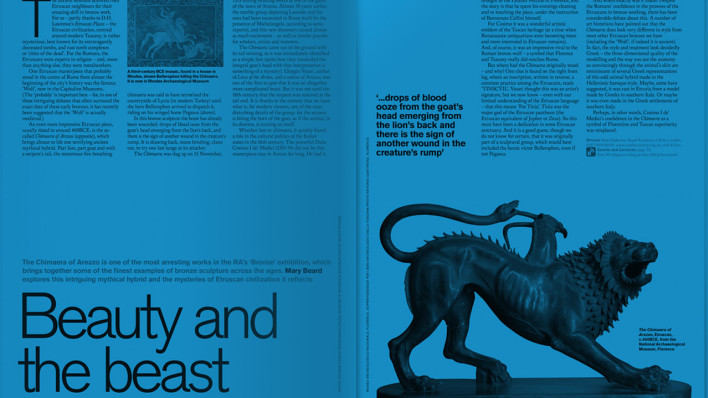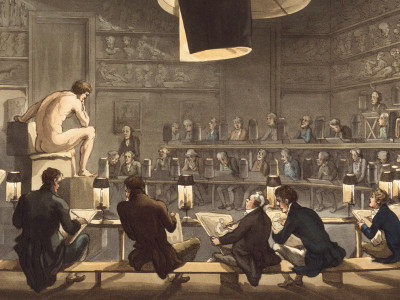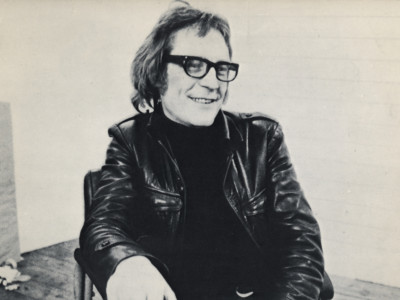
Painting on the threshold: Ian McKeever RA on Diebenkorn and abstraction
By Ian McKeever RA
Published on 2 March 2015
As the Academy celebrates the American master, painter Ian McKeever RA explores Richard Diebenkorn’s profound inquiry into the nature of abstraction.
From the Spring 2015 issue of RA Magazine, issued quarterly to Friends of the RA.
Paint is slippery stuff. It drips, pours, spreads, pools, thickens, thins, slips and slides; once out of the tube or can, it is almost formless. Unlike most materials used by artists, which retain something of their inherent form in the making process, giving the artist an intrinsic structure to build upon, paint, its fluidity, rubs right up against the artist’s sensibility.
This makes for a raw engagement, one often difficult for the painter to get their hands on. Much of painting’s history over the last 200 years has been about this predicament: paint’s illusive nature and how the artist either tames it, or lets it run wild. For paint either heats up the artist’s temperament, encourages excess, or else it is held in stasis by the artist, somehow stilled as it is applied to the canvas. Either way, most painters struggle with this beast in one way or another. For painting is first and foremost a declaration and display of temperament. Before all else, it is this we feel when we engage as a viewer with a painting.
The American artist Richard Diebenkorn Hon RA painted Ocean Park #79 (below) in 1975. It is one of an extensive group of abstract paintings, all with the title Ocean Park, which he made between 1967 and 1985, eight years prior to his death in 1993. They evolved, one leading to the next, their collective identity slowly becoming discernible with time. There are now 125 such paintings. They represent what is considered to be the third and last phase of Diebenkorn’s oeuvre, the ‘Ocean Park’ series having been preceded by an overtly figurative middle period, which itself followed on from an early phase of work. These early paintings were again abstract, however in a different way to the later ‘Ocean Park’ series, in that they were more rooted in the biomorphic forms of the Abstract Expressionists, more specifically in the work of fellow Americans, the painters Arshile Gorky and Robert Motherwell.

If the early abstract works by Diebenkorn are composed of flowing interlocking forms, then the ‘Ocean Park’ series is distinctly angular and urban. Although appearing counter intuitive, in going from abstraction, to figuration, then back again to abstraction, the trajectory of Diebenkorn’s work does in fact pursue a clear inquiry into the nature of what, in painting, abstraction might be.
By contemporary standards, in comparison to, say, the consciously theatrical mega-pictures of Anselm Kiefer Hon RA or David Hockney RA, Ocean Park #79 is not a big painting. It measures 236.2cm x 205.7cm. Indeed its size could be said to hold a relative modesty, a characteristic common to Diebenkorn’s work. Higher and wider than a doorway, yet still having a sense of the scale of the human body, perhaps the height and width of a man with arms raised high or spread wide, this human scale seems important to the painting. Indeed the paintings in Diebenkorn’s ‘Ocean Park’ series seem actively to want to pull us back to our own physical place in the world, to find an intimate contact with the viewer, whereby it becomes a specific one-to-one, body-to-body relationship. The body that is the painting and the body that is our own.
A painting is a door. It is also a threshold. Grace Hartigan, the American painter, said, ‘I want a surface that resists, like a wall, not opens like a gate.’ We could say that one of the fundamental differences between American and European painting is how space is handled. American painting tends to be flatter, the image,if there is one, more emblematic, a quality typified in something like Jasper Johns Hon RA’s ‘Flag’ paintings or the stylised still-lives of, for example, Wayne Thiebaud. Space in European painting, on the other hand, tends to be more nuanced, and there is greater spacial depth. Diebenkorn is often referred to as having a European sensibility because of his use of space. The paintings in the ‘Ocean Park’ series do have a flatness to them, as has all his work, yet at the same time the space in them is finely nuanced, oscillating between the sensation of looking down, as in an aerial view, while at the same time looking straight ahead, suggesting a doorway, a space we can enter.
A pronounced vertical and horizontal view is presented to us. In most of the ‘Ocean Park’ paintings horizontal bands are running predominantly across the upper part of the painting, these being met either by vertical columns or a more open, generalised space, imbuing the paintings with a strong architectural feel (Ocean Park #116, 1979, below). One is reminded of the look of the frescoes of Pompeii, or of some early Italian painting, where figures meet architectural features and both become subsumed in a broader composition, attaining, as Roberto Longhi wrote in reference to Piero della Francesca (below), a reduction back to ‘demonstrations of surfaces’.
It is curious that the more paint one puts on a painting, builds the surface up, the less depth the painting has. It reverts to becoming material, flat paint. After all, a blob of paint is first and foremost just that, a blob of paint. It is also often the case that as a painter gets older, the application of paint gets thinner, more sparse. Think of the late paintings of Edvard Munch or Henri Matisse. Less becomes more, and transparency begins to annul the materiality of paint. With Diebenkorn’s ‘Ocean Park’ paintings the accretion of transparent thin washes of paint gives the paintings a sense of inner space and light.

Ocean Park #116, 1979

Legend of the True Cross: Annunciation, c.1452
In the Church of San Francesco, Arezzo
It is by light,
I come to know you.
It is by breath.
It is by light,
I come to know you.
Peter Levitt, A Book of Light (1982)
Paintings either breathe in, or they breathe out. One only needs to look at the large brooding painting by Sean Scully RA, Doric Night (2011), currently on display in the Academicians’ Room, to see that it is sucking in air as fast as one can breathe. And the light too. In Diebenkorn’s paintings, especially the ‘Ocean Park’ series, one senses strongly the dry brittle light of where the desert meets the ocean. A crystalline light, noticeably different to the moisture-softened light we have here on the British Isles.
Diebenkorn said, ‘I arrive at the light only after painting in it, not by aiming for it.’ For the painting to hold the light, as opposed to depicting it by the means of chiaroscuro and shading, would seem to be what Diebenkorn is aiming for. A state in which the space in the painting is self-illuminating, almost transcendent. Such omnipresent light takes us back to Italian Duecento and Trecento painting, to a light before the slant of the shadow and human tainting. A time when form was in pure colour.
The American painter Willem de Kooning, when asked about abstraction in painting, said it was the smile on a Dutch man’s face. Georgia O’Keeffe, another American artist, when asked about an abstract drawing she had made, replied that it was about a headache. Our usual understanding of abstraction in art is that artists begin with something visually realistic in the world, and then somehow modify it, simplify it away from its original recognisable form.
But are there other ways to understand abstraction? In his book, Early Christian Art (1967), Frederic van der Meer writes of, ‘this constant double image – prefiguration and fulfilment, shadow and reality, past and present...’, words which are redolent with the complexities of attempting to paint an abstract painting. For the painting must find itself, and hold itself, in a condition whereby figuration is never declared and fulfilment is withheld, yet it must suggest a presence; a precarious state, a sort of waiting to be.
The term ‘prefiguration’, as used by Van Der Meer, is perhaps helpful in understanding the nature of the abstract in Diebenkorn’s late works. If our conventional understanding of abstraction in painting is that the image somehow moves away from the concrete object, be it a chair, an apple or indeed the human body, becoming in the process more ‘abstract’, then prefiguration suggests something prior to the object actually being perceived. A kind of painting that is formed in the artist’s mind before the concrete world appears. This is perhaps what Diebenkorn referred to as ‘not representing’.
Certainly in the architectonic spaces set up in the ‘Ocean Park’ paintings, there is a sense of expectancy, as if the space is waiting for the figure to materialise, to come into being. Yet, curiously enough, we somehow know it will not arrive, and the empty space in the paintings takes on a significance whereby absence becomes more weighted than presence (Ocean Park #43, 1971, below). This pregnant space is not new to painting. One need only think of Simone Martini’s incredibly beautiful painting, from 1333, of the Annunciation in the Uffizi in Florence. Flanked on the left side by the Archangel Gabriel and to the right the unsuspecting Virgin, the empty central area of the painting is, literally, pregnant with expectation (below). The Annunciation’s ‘abstract-ness’ is the subject of the painting.

Ocean Park #43, 1971

The Annunciation with Two Saints and Four Prophets, 1333
Perhaps related to this is a sense of time. For paintings are as much about holding time, their own time, as they are about form and space. The time it takes for apparently empty, abstract space to begin to hold potential meaning or the waiting for meaning to configure itself. Of course, wedded to this is also a sense of stillness, a slowing down. Have you noticed how fast-painted paintings are seldom quiet, rarely hold still? The art critic Adrian Stokes wrote, ‘The great work of art is surrounded by silence.’ One senses in the ‘Ocean Park’ series that this was something Diebenkorn was striving for, to still the painting, whereby we too, as viewers, are invited to be still. They are meditative paintings, in no rush to reveal themselves. Paintings that need time.
In our contemporary world of ceaseless moving images, where pictures bounce forth to meet us as soon as we get up in the morning, there is a fundamental question of what painting is for today. Many contemporary painters now embrace the new technologies and the pace of the modern visual world, run with the pack so to speak. Indeed much of postmodernism’s raison d’être has been about assimilating the canon of painting into its fold. However, for some painters, and Diebenkorn is certainly among them, there is always one fundamental question: what is specific to painting, sovereign to painting, that allows it to find its own place in the world? To stand alone, to be of itself, above and beyond references to other visual media, whereby we are left with no crutches, but have to face the painting emphatically as painting.
This question asked now, in an art world that is so self-consciously knowing, and where a belief in painting per se is treated with scepticism, might appear naïve. Yet the question is still pertinent, and the reason why the paintings of Richard Diebenkorn are so relevant.
Richard Diebenkorn is in The Sackler Wing at the RA from 14 March — 7 June 2015.

Enjoyed this article?
As well as free entry to all of our exhibitions, Friends of the RA enjoy one of Britain’s most respected art magazines, delivered directly to your door.
Why not join the club?
Related articles

Visions from Ukraine
19 June 2024

10 RA Schools stories through the centuries
16 May 2024

In memoriam: Mick Moon RA
1 May 2024